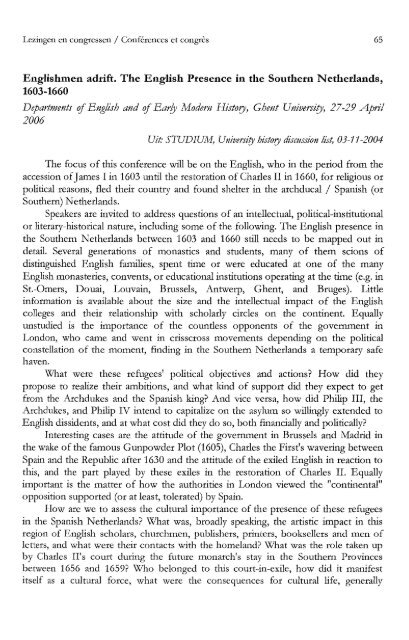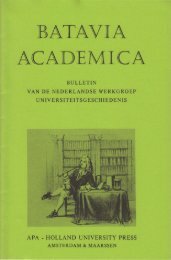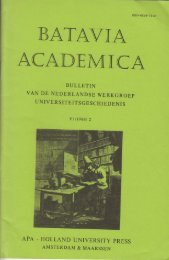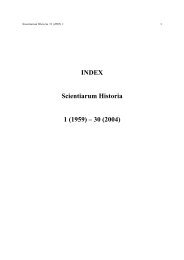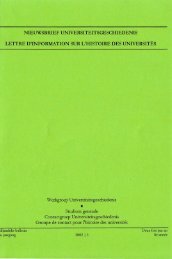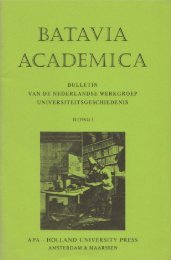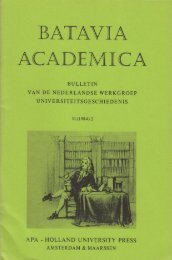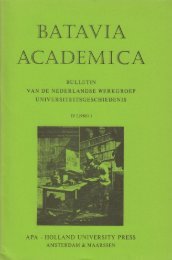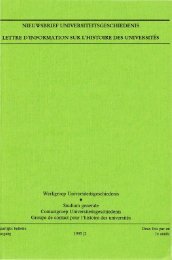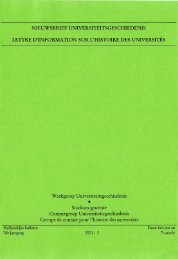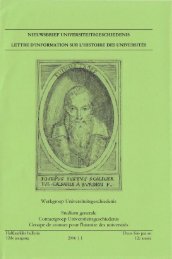Jaargang / Année 10, 2004, nr. 2 - Gewina
Jaargang / Année 10, 2004, nr. 2 - Gewina
Jaargang / Année 10, 2004, nr. 2 - Gewina
Create successful ePaper yourself
Turn your PDF publications into a flip-book with our unique Google optimized e-Paper software.
Lezingen en congressen / Conferences et cot1gres 65<br />
Englishmen adrift. The English Presence in the Southern Netherlands,<br />
1603-1660<br />
Departments of English and of Ear!J Modern History, Ghent University, 27-29 April<br />
2006<br />
Uit: STUDIUM, Universiry history discussion list, 03-11-<strong>2004</strong><br />
The focus of this conference will be on the English, who in the period from the<br />
accession of James I in 1603 until the restoration of Charles II in 1660, for religious or<br />
political reasons, fled their cow1try and found shelter in the archducal / Spanish (or<br />
Southern) Netherlands.<br />
Speakers are invited to address questions of an intellectual, political-institutional<br />
or literary-historical nature, including some of the following. The English presence in<br />
the Southern Netherlands between 1603 and 1660 still needs to be mapped out in<br />
detail. Several generations of monastics and students, many of them scions of<br />
distinguished English families, spent time or were educated at one of the many<br />
English monasteries, convents, or educational institutions operating at the time (e.g. in<br />
St.-Omers, Douai, Louvain, Brussels, Antwerp, Ghent, and Bruges). Little<br />
inf01mation is available about the size and the intellectual impact of the English<br />
colleges and their relationship with scholarly circles on the continent. Equally<br />
unstudied is the importance of the countless opponents of the government in<br />
London, who came and went in crisscross movements depending on the political<br />
constellation of the moment, finding in the Southern Netherlands a temporary safe<br />
haven.<br />
What were these refugees' political objectives and actions? How did they<br />
propose to realize their ambitions, and what kind of support did they expect to get<br />
from the Archdukes and the Spanish king? And vice versa, how did Philip III, the<br />
Archdukes, and Philip IV intend to capitalize on the asylwn so willingly extended to<br />
English dissidents, and at what cost did they do so, both financially and politically?<br />
Interesting cases are the attitude of the government in Brussels and Madrid in<br />
the wake of the famous Gw1powder Plot (1605), Charles the First's wavering between<br />
Spain and the Republic after 1630 and the attitude of the exiled English in reaction to<br />
this, and the part played by these exiles in the restoration of Charles II. Equally<br />
important is the matter of how the authorities in London viewed the "continental"<br />
opposition supported (or at least, tolerated) by Spain.<br />
How are we to assess the cultural importance of the presence of these refugees<br />
in the Spanish Netherlands? What was, broadly speaking, the artistic impact in this<br />
region of English scholars, churchmen, publishers, printers, booksellers and men of<br />
letters, and what were their contacts with the homeland? What was the role taken up<br />
by Charles II's court during ilie future monarch's stay in the Souiliem Provinces<br />
between 1656 and 1659? Who belonged to this court-in-exile, how did it manifest<br />
itself as a cultural force, what were the consequences for cultural life, generally


